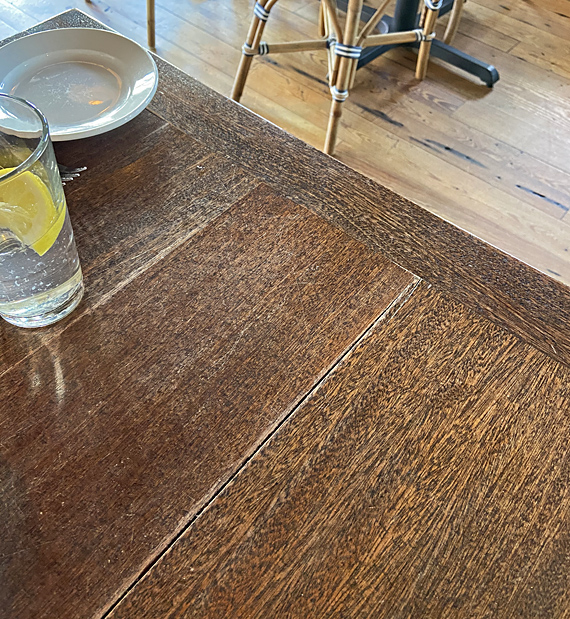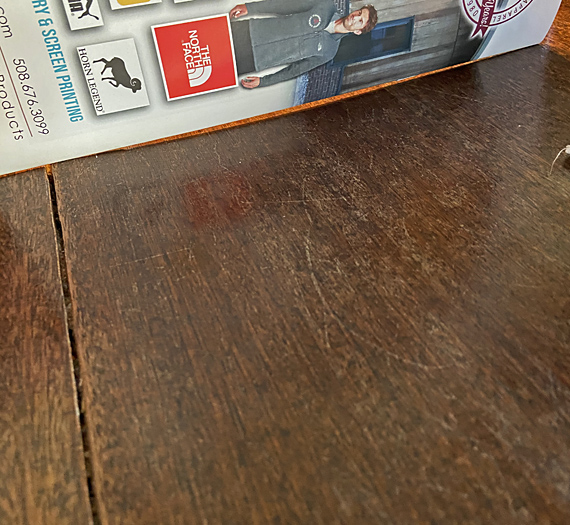
The companions seated at a restaurant table with an avid woodworker may find it odd that while they are studying the menu, the wood guy is studying the table. But much can learned by observing wooden structures in the wild, and so it was at a recent outing – just a few moments to choose the sashimi, but now let me see what’s going on with this table.
The big split (above) is easy to diagnose. There is a breadboard end cap running cross grain to the main section, and is no doubt glued along its entire length. It probably took only a year or less for the wood, probably dark red meranti, to split during a dry season when it was restrained from shrinking across the grain by the long grain length of the end cap.
Was the maker unaware of the problem inherent in the construction? Was it made just to look good at delivery without regard for its fate? One wonders.
The split appears to be along an edge joint. As I have discussed in an earlier post, this is not a coincidence. The edge joint was weaker than the wood, a situation with many possible causes and that woodworkers try hard to avoid. My extensive series on the edge joint can help prevent this from happening to your work!

What about the concavity in the top surface? In the photo just above, I am demonstrating the warp in the surface using the straight edge of the spine of a brochure. (Sorry, I didn’t have my Starrett with me.) Seasonal movement of flatsawn wood perhaps? No, the wood does not look flatsawn, and I am almost certain this same cup is present year round, and eventually in most of the tables there.
The finish on the tabletop eventually deteriorates from repeated wetting, scratches, and perhaps ultraviolet light exposure. Liquid water, inevitably and repeatedly on a restaurant table, can then enter the wood fibers near the top of the board and swell them. The top surface of the board wants to get wider across the grain. But each time the fibers swell, they are compressed against each other, probably aggravated by the top of the board being relatively restrained from expanding by the drier bottom of the board, along with other aspects of the construction. The fibers undergo permanent deformation; they get crushed. This is compression set.
Later, when the top of the board re-equilibrates to a drier state, the crushed fibers want to shrink the width of the board. The board thus becomes concave on its top surface. This effect is irrespective of the usual come-and-go of flatsawn cupping, which may be additive to it.
It is important to realize that these hygroscopic forces of wood movement are stronger than the wood structure itself.
Taking a walk on a wood deck later that day, the boards showed another example of this.
We have to consider how the woodwork we make will fare long after it has left our hands. It is good to remember Yogi Berra’s advice, the title of this post.
[Who is the player with the most World Series championshhips in Major League Baseball history? Yup, it’s the great philospher himself, Yogi.]


The inclination of concavity of some boards has been demonstrated to be even more pronounced in decking boards with different surface finishes with some of the repair work I do. If the board can not move because it is sealed on top with a polyurethane or surface sealer and not a permeable breathable oil which can allow moisture to move through the problem appears to be exacerbated as the bottom of the board is unrestricted in the take up of moisture. In extreme cases I have seen decking screws break unlike nails which bend quite a bit. Wood movement really does impress itself upon you when a chance to study your own work over many years is possible. Fingers crossed the execution of the bread board ends on my mother in laws coffee table have held up well and the top has remained flat . Time will tell although the shrinkage seems to have minimised as the piece acclimatised to her house.
Thanks for the comment, Gav. So all that talk about wood warping the opposite way in the Land Down Under is just myth, right? Ha, seriously, yes, it is instructive to observe our work in the wild years later.
Rob
Upside down, back to front yes we have it all. Actually a lot of the stuff relating to native timbers here are not just hearsay. They often are heavy, dense and devious in the ability to blunt tools. The movement side of things can be instructive. Much of the plantation softwood grown here moves a tremendous amount, even the furniture grade, so giving it time can work wonders or getting it from New Zealand! I only located the bread board ends on the coffee table in the middle but owing to the width cheated a bit and used a small amount of very flexible flooring glue towards the ends. The top shrank by nearly 6mm across 600mm even though all the jarrah was stored for many years and the same moisture content. No cracks or bowing however so I seem to have allowed enough for it. Funnily enough some of the movement regarding cupping does seem to be contrary with some of the jarrah I have seen externally. Rough sawn can be hard to read. I read a really interesting article about native timber recovered from lakes in Australia and how some of the traditional methods of processing can be altered because the water had driven out all the sap and it is more stable . Wood tricks never stop.
Thanks again, Gav, for these perspectives on Aussie woods. I love Tasmanian blackwood.
Yes, interesting how plantation grown woods differ from the same species in the wild. Big-leaf mahogany is like that.
Rob
My wife catches me all the time – checking out the tables and chairs or even exposed ceiling trusses.
One of our regular restaurants replaced the tables and chairs. The tables were really nice looking with tight breadboards. I predicted future issues to my wife and they did start showing up pretty quickly.
It’s nothing new, you’d think it wouldn’t be encountered so often.
Yea, John, I wonder if it is lack of knowledge, a crass get-‘er-done approach, or just an attitude that says make it look good at delivery then run, hoping that the client will just assume that’s what normally happens to wooden things.
Rob